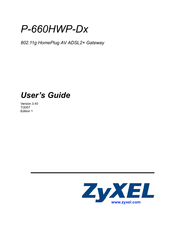ZyXEL Communications P-660HWP-Dx Manuals
Manuals and User Guides for ZyXEL Communications P-660HWP-Dx. We have 3 ZyXEL Communications P-660HWP-Dx manuals available for free PDF download: User Manual, Support Notes, Quick Start Manual
ZyXEL Communications P-660HWP-Dx User Manual (402 pages)
802.11g HomePlug AV ADSL2+ Gateway
Brand: ZyXEL Communications
|
Category: Gateway
|
Size: 12 MB
Table of Contents
-
-
-
-
-
User Access44
-
Wizards57
-
-
-
-
Introduction59
-
-
-
-
Introduction73
-
Network79
-
-
-
WAN Overview81
-
WAN Setup81
-
Multiplexing82
-
Metric84
-
Nat84
-
-
LAN Overview99
-
LAN Setup99
-
-
DHCP Setup100
-
IP Pool Setup100
-
Lan Tcp/Ip101
-
Multicast102
-
RIP Setup102
-
Any IP103
-
-
Figure 55 LAN IP104
-
Table 26 LAN IP105
-
DHCP Setup106
-
LAN Client List107
-
LAN IP Alias108
-
Requirements112
-
Ssid113
-
Encryption114
-
Wpa-Psk/Wpa2-Psk118
-
Wpa/Wpa2120
-
-
How any IP Works104
-
Wireless LAN111
-
-
No Security117
-
WEP Encryption117
-
Enabling OTIST123
-
Otist123
-
Figure 68 OTIST124
-
Table 38 OTIST124
-
MAC Filter127
-
WMM Qos128
-
WMM Qos Example128
-
Services129
-
Qos Screen130
-
-
Wireless Client124
-
Starting OTIST125
-
Notes on OTIST126
-
Qos Screen131
-
-
Overview135
-
Powerline135
-
-
-
NAT Definitions143
-
NAT Overview143
-
How NAT Works144
-
NAT Application144
-
What NAT Does144
-
Sip Alg146
-
Address Mapping151
-
-
Port Forwarding148
-
Security155
-
-
-
Firewalls157
-
Basics159
-
-
-
TCP Security164
-
Packet Filtering167
-
-
Access Methods169
-
-
Rule Checklist170
-
Alerts172
-
LAN to WAN Rules172
-
Anti-Probing185
-
Dos Thresholds186
-
Threshold Values186
-
-
-
-
-
My Certificates198
-
Certificates195
-
-
-
Advanced217
-
Part V: Advanced217
-
Static Route219
-
Diffserv230
-
-
-
-
-
Trusted cas206
-
-
-
Scheduler224
-
-
-
-
System Timeout240
-
Www240
-
Supported Mibs244
-
Configuring SNMP245
-
SNMP Traps245
-
Configuring DNS246
-
Configuring ICMP247
-
248248
-
Snmp243
-
-
Telnet241
-
Configuring FTP242
-
-
-
-
-
NAT Traversal251
-
Configuring Upnp252
-
-
Upnp and Zyxel252
-
-
-
General Setup265
-
System265
-
Time Setting267
-
Logs271
-
Log Descriptions275
-
Restart293
-
Diagnostic295
-
Troubleshooting297
-
Firmware Upgrade289
-
-
Chapter 20 Logs
271-
Logs Overview271
-
Viewing the Logs271
-
Tools289
-
-
Chapter 21 Tools
289 -
-
-
Wpa and Wpa2319
-
-
-
-
Table 145 Menu 3328
-
-
-
Macintosh os X351
-
Advertisement
ZyXEL Communications P-660HWP-Dx Support Notes (134 pages)
802.11g HomePlug AV ADSL2+ Security Gateway
Brand: ZyXEL Communications
|
Category: Gateway
|
Size: 2 MB
Table of Contents
-
Faq7
-
-
Product FAQ14
-
What Is DDNS15
-
Adsl Faq20
-
Hpav Faq23
-
General25
-
Wireless FAQ34
-
General FAQ34
-
Advanced FAQ39
-
-
Security FAQ42
-
What Is WEP42
-
What Is WPA42
-
-
-
SUA Notes49
-
Using Syslog75
-
ZyXEL Communications P-660HWP-Dx Quick Start Manual (13 pages)
802.11g HomePlug AV ADSL2+ Gateway
Brand: ZyXEL Communications
|
Category: Gateway
|
Size: 0 MB
Table of Contents
Advertisement
Advertisement
Related Products
- ZyXEL Communications P-660HWP-DX - V3.40
- ZyXEL Communications P-660HW Series
- ZyXEL Communications P-660HW-D Series
- ZyXEL Communications P-660HW-TX
- ZyXEL Communications P-660HW-Tx v3 Series
- ZyXEL Communications P-660HW-DX
- ZyXEL Communications P-660HW-T3 v3
- ZyXEL Communications P-660HW-Tx v2 Series
- ZyXEL Communications P660HW3
- ZyXEL Communications P-660HWP-D1


